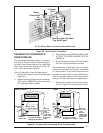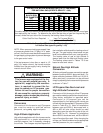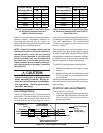
27
thermometer on the supply air side must be
shielded from direct radiation from the heat
exchanger to avoid false readings. Adjust all
registers and duct dampers to the desired posi-
tion and run the furnace for fifteen minutes
before taking any temperature readings. The
temperature rise is the difference between the
supply and return air temperatures.
For typical duct systems, the temperature rise
will fall within the range specified on the rating
plate with the blower speed at the factory recom-
mended setting. If the temperature rise mea-
sured is outside the range specified, it may be
necessary to change the blower speed. Lower
blower speeds will increase the temperature rise
and higher blower speeds will decrease the
temperature rise.
The furnace is equipped with a multispeed mo-
tor. Heating and cooling speed selection is made
by moving the leads on the integrated control
board located in the furnace. The wiring diagram
on the furnace and Figures 25, 26 and 27 show
the speed taps for adjusting motor speed.
If it is desired that the blower operate at the
same speed for heating and cooling, tape off the
terminal of the unused blower wire. Install the
jumper wire, found in the plastic instruction bag,
across the HEAT and COOL taps on the control
board. Reconnect the desired blower tap to the
piggyback quick connect.
The blower control is designed to start the
circulating air blower 30 seconds after the gas
valve is opened. The blower control is factory
wired to turn the blower motor off 120 seconds
after the gas valve is closed. This timing can be
changed using the BLOWER OFF timing switch
opposite the terminal block on the control board.
(See Figure 25.)
Verifying Burner Operation
To verify operation of the burners, make sure
that the blower compartment door is in place and
that there is power to the furnace. Set the
thermostat above room temperature and ob-
serve the ignition sequence. The flame can be
observed through the small clear window on the
burner box. The burner flame should carry over
between all burners. The flames should be blue,
without yellow tips. Flames should extend from
each burner without lifting, curling, or floating.
After verifying ignition, set the thermostat below
room temperature and verify that the burner
flame extinguishes completely.
Use the following procedure to determine the
firing rate:
1. Shut off all other gas fired appliances.
2. Start the furnace and allow it to run for at
least three minutes.
3. Measure the time (in seconds) required for
the gas meter to complete one revolution.
4. Convert the time per revolution to cubic feet
of gas per hour using Table 12.
5. Multiply the gas flow rate in cubic feet per
hour by the heating value of the gas in Btu
per cubic foot to obtain the firing rate in
Btuh. Example:
• Time for 1 revolution of a gas meter with
a 1 cubic foot dial = 40 seconds.
• From Table 9 read 90 cubic feet per hour
of gas.
• Heating value of the gas (obtained from
gas supplier) = 1040 Btu per cubic foot.
• Firing rate = 1040 x 90 = 93,600 Btuh.
6. Adjustments to the firing rate can be
made by adjusting the gas manifold
pressure. See the High Altitude
Application section for additional
information of firing rate at elevations
above 2000 ft.
The manifold pressure must be set to the appro-
priate value for your installation. Refer to either
Table 7 for natural gas or Table 8 for LP/propane
gas to verify the manifold pressure setting re-
quired for your particular installation. To adjust
the manifold pressure, remove the regulator cap
and turn the adjusting screw clockwise to in-
crease pressure or counterclockwise to reduce
pressure. Replace the regulator cap after adjust-
ments are complete.
!
CAUTION:
Do not re-drill the burner orifices. If
the orifice size must be changed, use
only new orifices.
Verifying and Adjusting
Temperature Rise
Verify that the temperature rise through the
furnace is within the range specified on the
furnace rating plate. Temperature rises outside
the specified range could result in premature
heat exchanger failure.
Place thermometers in the return and supply air
stream as close to the furnace as possible. The


















